Access Agilent eNewsletter July 2016
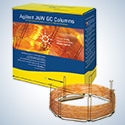
Agilent J&W DB-624UI capillary GC column excels for challenging applications with active compounds
Laura Provoost, Agilent GC Columns Product Manager
The stationary phase for the 624 GC column was first designed in 1986 for analyses of volatile organic compounds listed in US EPA Method 624. But this stationary phase, which has a composition of 6% cyanopropyl phenyl and 94% polydimethylsiloxane, traditionally has shown reactivity with acidic and basic compounds, causing peak tailing and poor sensitivity. The Agilent J&W DB-624UI GC column overcomes these problems. A unique deactivation process for this Ultra Inert (UI) column enhances peak shape, improves signal-to-noise, and increases sensitivity for qualitative and quantitative analyses.
In addition to traditional applications performed by the classical 624 stationary phase, you can use the Agilent J&W DB-624UI for a number of difficult chromatographic applications that are atypical for this stationary phase. In this article, Agilent J&W DB-624UI column performance is examined for both types of applications.
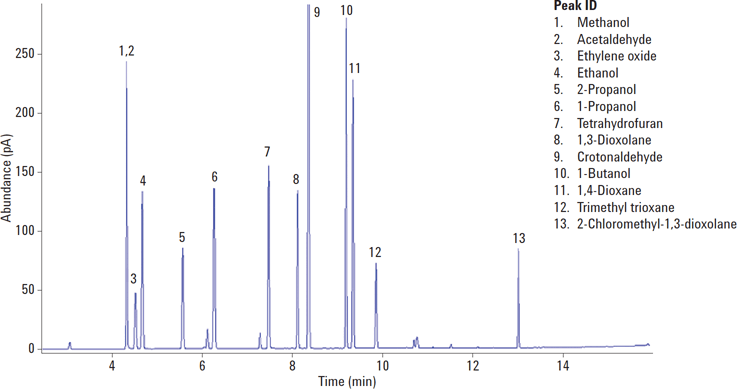
Figure 1. Sharp peaks for oxygenated compounds in waste water.
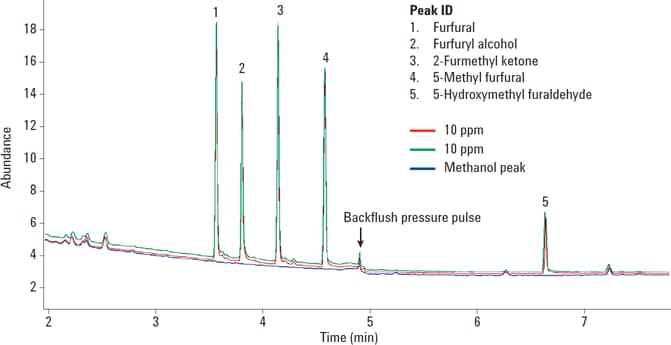
Figure 2. Inert column provides good peak shapes for furans analysis.
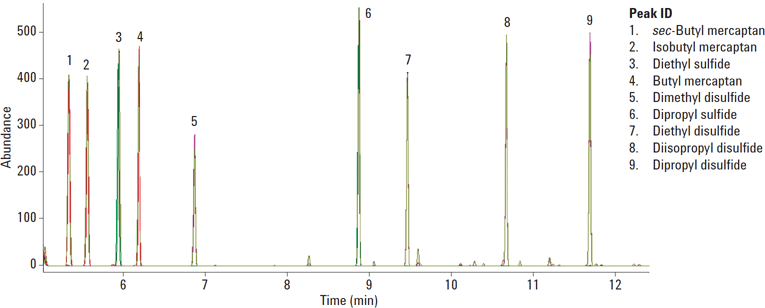
Figure 3. Inert DB-624UI phase is ideal for analysis of difficult sulfur-containing compounds in hydrocarbon matrix.
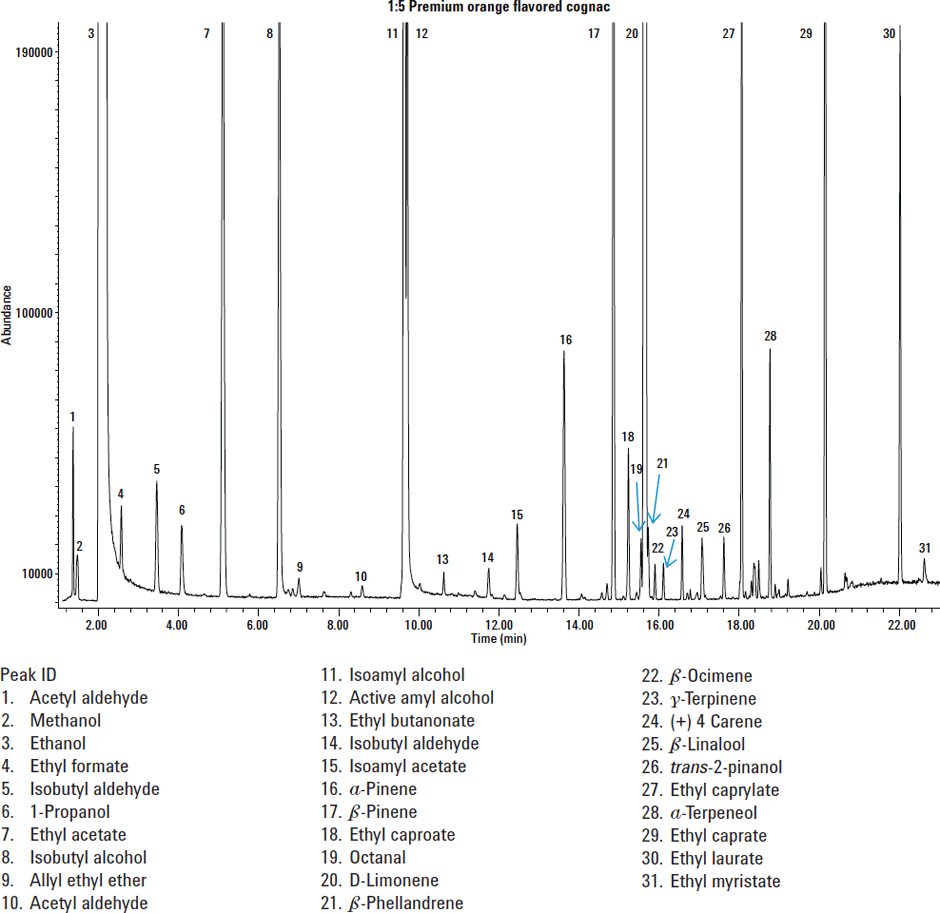
Figure 4. No peak tailing in this TIC of orange-flavored cognac diluted 1 to 5 with distilled water in the headspace vial on an Agilent J&W DB-624UI, 30 m × 0.32 mm, 1.8 µm column.
Trace analysis of oxygenated compounds in wastewater
Common oxygenated industrial chemicals are monitored at trace levels in waste or process water. The DB-624UI shows respectable separation and excellent peak efficiencies, as illustrated in Figure 1. In this example, samples were analyzed by headspace/GC/FID with an Agilent J&W DB-624UI 60 m × 0.32 mm, 1.8 µm column. The concentrations of the analytes of interest were 100 ppm (w/w) in water.
Reliable furans analysis for cellulose degradation monitoring
Furans are a group of toxic chemicals that can be produced from chemical processes such as chlorine bleaching in paper production, combustion, or cellulous degradation. Trace levels can be found ubiquitously in the environment. The inertness of the Agilent J&W DB-624UI phase for this class of molecules makes it ideal for their chromatographic separation. Figure 2 shows an overlay of chromatograms of 10 ppm (w/w) of furans in methanol using two coupled Agilent J&W DB-624UI columns:
- 2 m × 0.32 mm, 1.8 µm column employed as a guard column
- 10 m × 0.32 mm, 1.8 µm column cut from a 60 m × 0.32 mm, 1.8 µm column
Ideal column for sulfur-containing compounds in hydrocarbons
Because of their reactivity and adsorption to active surfaces, the analysis of sulfur-containing molecules was a challenge in the past. But this new stationary phase showed a high degree of inertness, even with volatile molecules such as methyl and ethyl mercaptans (Figure 3). Samples were analyzed by GC/FID with an Agilent J&W DB-624UI, 60 m × 0.32 mm, 1.8 µm column.
Symmetrical peak shapes for analysis of distilled spirits
In addition to industrial applications, the highly inert Agilent J&W DB-624UI GC column is an excellent choice for analysis of distilled spirits by static headspace GC/MS. Figure 4 shows that the total ion chromatogram (TIC) of a premium orange-flavored cognac displayed a good screening profile for the spirit. Note the excellent peak shapes for the aldehydes in the chromatogram (peaks 1, 5, 10, 14, and 19). Aldehydes can be a challenge to chromatograph due to their reactivity. In this case, there was no evidence of peak tailing, which is often observed when analyzing these reactive compounds.
For more information about this and similar distilled spirit analyses, consult Agilent publication 5991-0659EN.
Stellar peak shape means you analyze difficult compounds at lower levels
Agilent J&W DB-624UI GC columns are well suited for analyses of the most challenging sample components. Compared with traditional 624 phases, these columns represent a major breakthrough in inertness. This stationary phase also demonstrates low bleed and a unique selectivity. Agilent controls quality with an Ultra Inert test mix, which guarantees column-to-column inertness for the most stringent probes.
For more information, read Agilent Application Note 5991-0845EN, which describes the successful analysis of problematic volatile organic acids, including C1-C10 organic acids. For more information on the use of the Agilent J&W DB-624UI for challenging industrial applications, please read application note 5991-5197EN. Then discover more about columns that can reduce detection limits and improve peak shape and linearity for your challenging chemically active compounds.
Stay informed about the applications that are important to you
Subscribe to Access Agilent
Our free customized
monthly eNewsletter
All articles in this issue
 Make your Q-TOF LC/MS analyses faster, easier, and more productive—regardless of your application
Make your Q-TOF LC/MS analyses faster, easier, and more productive—regardless of your application Agilent J&W DB-624UI capillary GC column excels for challenging applications with active compounds
Agilent J&W DB-624UI capillary GC column excels for challenging applications with active compounds Tip: Using enzymes in dissolution testing of gelatin capsules
Tip: Using enzymes in dissolution testing of gelatin capsules InfinityLab Poroshell 120 columns maximize LC workflow efficiency
InfinityLab Poroshell 120 columns maximize LC workflow efficiency Emerging life science applications of FTIR Imaging: Providing spatially resolved molecular information in disease research
Emerging life science applications of FTIR Imaging: Providing spatially resolved molecular information in disease research New LC/TQ database and method for central carbon metabolites
New LC/TQ database and method for central carbon metabolites Agilent QQQ systems enable ground-breaking research on use of metabolite biomarkers to predict a common pregnancy complication
Agilent QQQ systems enable ground-breaking research on use of metabolite biomarkers to predict a common pregnancy complication Analysis of PEGylated proteins with Agilent AdvanceBio SEC columns
Analysis of PEGylated proteins with Agilent AdvanceBio SEC columns Structural elucidation of in-process impurities using high resolution LC/MS/MS
Structural elucidation of in-process impurities using high resolution LC/MS/MS Removal of lipids for the analysis of toxicological compounds in plasma by LC/MS/MS
Removal of lipids for the analysis of toxicological compounds in plasma by LC/MS/MS Quick, accurate, cost-effective measurements of veterinary drugs in meat with Agilent MS/MS, UHPLC, and Q-TOF
Quick, accurate, cost-effective measurements of veterinary drugs in meat with Agilent MS/MS, UHPLC, and Q-TOF
Figure 1

Sharp peaks for oxygenated compounds in waste water.
Figure 2

Inert column provides good peak shapes for furans analysis.
Figure 3

Inert DB-624UI phase is ideal for analysis of difficult sulfur-containing compounds in hydrocarbon matrix.
Figure 4

No peak tailing in this TIC of orange-flavored cognac diluted 1 to 5 with distilled water in the headspace vial on an Agilent J&W DB-624UI, 30 m × 0.32 mm, 1.8 µm column.